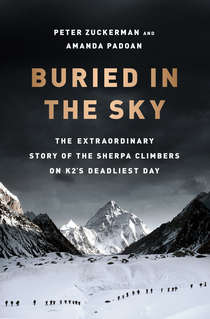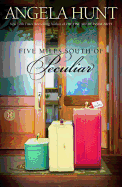 Buried in the Sky is an in-depth look at one of the most devastating climbing expeditions in the history of K2, the world's most dangerous peak. Amanda Padoan and Peter Zuckerman spent years researching the day in 2008 when 11 climbers died and traveled across the world to interview eyewitnesses. But their book has a special twist--it examines K2's deadliest day from the from the perspective of the men who set the ropes and carry the loads--high-altitude workers of the Sherpa, Bhote, Shimshali and Balti ethnicities.
Buried in the Sky is an in-depth look at one of the most devastating climbing expeditions in the history of K2, the world's most dangerous peak. Amanda Padoan and Peter Zuckerman spent years researching the day in 2008 when 11 climbers died and traveled across the world to interview eyewitnesses. But their book has a special twist--it examines K2's deadliest day from the from the perspective of the men who set the ropes and carry the loads--high-altitude workers of the Sherpa, Bhote, Shimshali and Balti ethnicities.
Buried in the Sky (just out from W.W. Norton) actually started for Padoan years earlier when her brother William, her climbing teacher and partner, died just before his 24th birthday. The two had been planning a trip to the Himalaya.
She recalled, "His death completely unhinged me. I shaved my head, left my mother a note on the kitchen table and went to climb in Tibet. I had no idea when I would come back. In the summer of 2004, I made my way to Pakistan where I attempted a 26,400-foot peak called Broad Peak, the mountain that faces K2. I didn't connect to the American and European climbers who shared my permit. They were there for a summit; I was there for an answer, maybe. I spent most of my free time with the Pakistani high-altitude porters. I appreciated their spirituality and enjoyed watching them perform salaat (prayer)."
One of those high-altitude porters was a man named Karim Meherban. "Karim reminded me of my brother because he was always looking out for me. After the climb, he returned to Shimshal, a village in the Karakorum, and I returned to Los Angeles to resume normal life as an attorney."
Four years later, Karim died on that tragic day on K2. As Padoan watched news reports from her home in Los Angeles, she felt that great loss again. "Perhaps it was like losing William a second time."
It was Karim's anonymity in all the news coverage that frustrated Padoan and made her want to pursue his story for the world to hear. However, Padoan was also nursing a newborn at this time. So she called in reinforcement, her cousin, journalist Peter Zuckerman. But Zuckerman had never climbed a mountain: "You can learn only so much by reading and watching people climb. I needed to do it. I had two of the main characters--Chhiring and Pasang--give me climbing lessons, using the same gear they used on K2. I hardly became the world expert on mountaineering, but the experience was invaluable. It also helped that my co-author is a mountaineer and that I spent several months trekking around Nepal and living with the Sherpas and high-altitude workers. This background shaped the kinds of questions I asked, the descriptions I wrote, and the angles I took, making the book more precise and compelling."
It also provided Zuckerman with some unrelated experiences, including eating yarsagumba. He explained in an article for Rock and Icemagazine, "Nobody knew what this thing was, but it looked harmless.... It resembled a shriveled caterpillar with a tumor growing from its forehead." The world's only half-plant, half-animal is believed to be medicine and eating it was all in the name of research, right? "It treats sunburn, strengthens nails, regenerates the hairline! It's the well-known Himalayan Viagra!"
When both Zuckerman and Pasang thought they were dying as a result of eating the yarsagumba, they phoned Padoan in the middle of the night for help. "So you're in a village in the Himalaya. You just OD'ed on a caterpillar with shrooms growing out its head--and want an evac on a Soviet-era helicopter?"
Zuckerman and Pasang obviously both lived through that experience, but even with Zuckerman learning to climb, the pair still had many obstacles to overcome to tell their story; a language barrier was one of the greatest. "In all we conducted interviews in 14 languages, at least four of which are considered rare or dying languages," Padoan explained.
Zuckerman added, "Interpreters were crucial to the research: some of the dialects the Sherpas and high-altitude porters spoke were so rare they were only used at one village. As a result, the interviews were excruciating. It often took weeks of trekking to get to a village and days trying to find the right person at that village. From there it might be several more days of drinking tea and hanging out to gain the trust of the person I wanted to interview. When the interviews started, questions and answers sometimes had to go through two layers of interpreters before they could be translated into English.
"Despite all that work, I still did not ask every question I should have, and there were no second chances in many instances. Like the disaster on K2, aspects of the story will probably always remain a mystery."
What made Padoan and Zuckerman's work so different from the extensive media coverage? Padoan explained, "There were blind spots in the initial coverage. It's extremely difficult to get accurate information unless you speak directly with eyewitnesses in their native language.
"I moonlighted as a mountaineering journalist for years, but my day job was working as a deputy district attorney. This background in trial law was useful when culling through the evidence to write Buried in the Sky. It taught me to seek out every witness I could, study every photo, video and audio recording I could find, while asking the basic questions: What hearsay is reliable or unreliable? What factors make a witness reliable or unreliable? K2 wasn't a crime scene, per se, but there were similarities--11 deaths, traumatized eyewitnesses, perceptions altered due to extreme physical and emotional stress."
And the other benefit Padoan had that many journalists did not was her network:
"I have been climbing in the Himalaya and Karakorum since I was a teenager, and my most enduring friendships are there. Maybe that's the definition of 'friends in high places,' because mountaineers went out of their way to help us. Nazir Sabir, a legendary mountaineer from Hunza, managed to get us critical interviews within Pakistani military bases and other highly restricted areas. Peter and I must have been the envy of the C.I.A."
Their hard work and determination paid off. Buried in the Sky, while the story of great devastation, is also a beautiful tribute to Padoan's friend Karim Meherban; he and and the other indigenous mountaineers no longer remain anonymous. --Jen Forbus of Jen's Book Thoughts
Amanda Padoan and Peter Zuckerman: K2's Deadliest Day



 Buried in the Sky is an in-depth look at one of the most devastating climbing expeditions in the history of K2, the world's most dangerous peak. Amanda Padoan and Peter Zuckerman spent years researching the day in 2008 when 11 climbers died and traveled across the world to interview eyewitnesses. But their book has a special twist--it examines K2's deadliest day from the from the perspective of the men who set the ropes and carry the loads--high-altitude workers of the Sherpa, Bhote, Shimshali and Balti ethnicities.
Buried in the Sky is an in-depth look at one of the most devastating climbing expeditions in the history of K2, the world's most dangerous peak. Amanda Padoan and Peter Zuckerman spent years researching the day in 2008 when 11 climbers died and traveled across the world to interview eyewitnesses. But their book has a special twist--it examines K2's deadliest day from the from the perspective of the men who set the ropes and carry the loads--high-altitude workers of the Sherpa, Bhote, Shimshali and Balti ethnicities. The Sleeping Beauty Trilogy by A.N. Roquelaure (pen name of Anne Rice). Wonderfully imaginative sexuality and plot, which is one of the things that makes good erotica stand out--it's more than one-handed reading.
The Sleeping Beauty Trilogy by A.N. Roquelaure (pen name of Anne Rice). Wonderfully imaginative sexuality and plot, which is one of the things that makes good erotica stand out--it's more than one-handed reading. 100 Strokes of the Brush Before Bed by Melissa P. A sexual coming-of-age novel that tells all. First published in Italy where it sold almost a million copies, it's been translated into 30 languages. The author claimed it was based on her own life. True or not, it's hot.
100 Strokes of the Brush Before Bed by Melissa P. A sexual coming-of-age novel that tells all. First published in Italy where it sold almost a million copies, it's been translated into 30 languages. The author claimed it was based on her own life. True or not, it's hot. The Bride Stripped Bare by Nikki Gemmell. A bored housewife has disappeared and left behind a diary of lessons to help fellow wives avoid the kind of tedious marriage she endured. This book has sex, suspense, psychodrama, anger, tenderness and terror.
The Bride Stripped Bare by Nikki Gemmell. A bored housewife has disappeared and left behind a diary of lessons to help fellow wives avoid the kind of tedious marriage she endured. This book has sex, suspense, psychodrama, anger, tenderness and terror.
 Book you're an evangelist for:
Book you're an evangelist for:










